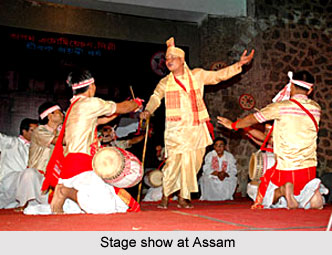Theatre Personalities of Assam boasts a glorious history of Assamese theatre from its bygone era. One type named Ankiya Nat or Bhaona, composed by Vaishnava reformers like Sankaradeva and Madhavadeva, are still staged in community halls termed nam-ghar by the theatre personalities of Assam.
 The theatre personalities of Assam perform different modes of theatre, such as Bhaoriya, Dhuliya, and Oja-Pali. In 1875, the theatre personalities of Assam with the help of theatre of a Western mould, with proscenium stage and Anglo-European dramatic structure, made its first appearance at Guwahati. Initially, the theatre personalities of Assam were held on temporarily erected stages. But permanent structures came up in the 1890s and by the second decade of the twentieth century, all the district and sub divisional towns, including a few semi-urban places, staged at least few shows by the theatre personalities of Assam every year. Usually the plays performed by the theatre personalities of Assam during festivals or important occasions are just for the pleasure of putting up a show.
The theatre personalities of Assam perform different modes of theatre, such as Bhaoriya, Dhuliya, and Oja-Pali. In 1875, the theatre personalities of Assam with the help of theatre of a Western mould, with proscenium stage and Anglo-European dramatic structure, made its first appearance at Guwahati. Initially, the theatre personalities of Assam were held on temporarily erected stages. But permanent structures came up in the 1890s and by the second decade of the twentieth century, all the district and sub divisional towns, including a few semi-urban places, staged at least few shows by the theatre personalities of Assam every year. Usually the plays performed by the theatre personalities of Assam during festivals or important occasions are just for the pleasure of putting up a show.
Early Assamese drama of this age by theatre personalities of Assam was in blank verse modeled on the Bengali amitrakshar metre that contained fourteen syllables in each line. Historical drama by the theatre personalities of Assam appeared alongside the mythological from the beginning of the twentieth century. The example can be given as Padmanath Gohain Barooah`s Jayamati in 1900. Maniram Dewan, Lachit Barphukan, and Piyali Phukan are the prominent theatre personalities of Assam who collectively formed the Nagaon Shilpi Samaj in the town of Nagaon.
From the mid-1950s, many one-act competitions were held all over Assam, and there were theatre personalities of Assam who specialized in writing short scripts. Until 1949, men portrayed female characters. There were a few attempts to cast women in the 1930s, in plays like, Braja Natha Sarma and others. In the early days, the theatre personalities of Assam acted in theatres that were lit by candles. But in later days hanging rows of kerosene lamps, gaslight, or pressure lamps lighted theatres in Assam. All these used to produce a very bright light. When portable power generators became available, they were pressed into service.
The theatre personalities of Assam worked vigorously with innovative plays in the first phase after Independence. The present trend of theatre in Assam, in keeping with the rest of the country, is to use local folk and traditional forms by the theatre personalities of Assam. The interface of theatre with cinema has also created some star theatre personalities of Assam, notably Phani Sarma, and creative directors like Dulal Roy and others.




















